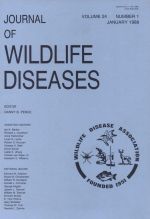Water from 10 saline wetlands in Saskatchewan was provided as drinking water for 1-day-old mallards (Anas platyrhynchos). Ducklings given water with conductivity from 3,750 to 7,490 μmhos/cm grew as well as birds on fresh water during a 14-day trial, but birds given water with conductivity of 4,000 μmhos/cm grew poorly during the last 2 wk of a 28-day trial. Ducklings given water with conductivity of 7,720 μmhos/cm grew poorly during a 14-day trial. Six of 10 ducklings given water with conductivity of 20,000 μmhos/cm died, and only two of nine ducklings given water with conductivity of 21,500 μmhos/cm survived 14 days. Survivors were much smaller than controls and had many abnormalities. All ducklings given water with conductivity of 35,000 and 67,000 μmhos/cm died within 60 and 30 hr, respectively. The results indicate that ducklings hatched on many saline wetlands will suffer toxic effects unless they are able to find a source of fresh water shortly after hatching.
How to translate text using browser tools
1 January 1988
TOXIC EFFECTS OF NATURAL SALINE WATERS ON MALLARD DUCKLINGS
S. A. Mitcham,
G. Wobeser

Journal of Wildlife Diseases
Vol. 24 • No. 1
January 1988
Vol. 24 • No. 1
January 1988
Anas platyrhynchos
ducklings
experimental study
growth
pathology
salinity
toxicity




